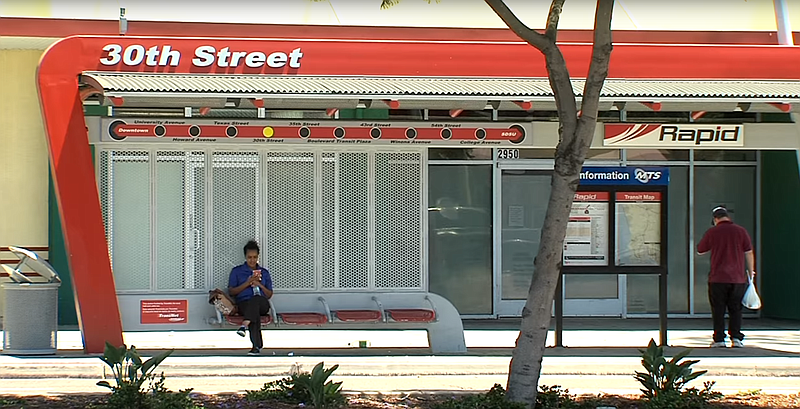Just over a year after the passage of San Diego’s Climate Action Plan, the city’s goal of dramatically shifting its residents’ commuting habits away from cars and toward public transit is slipping further from reach.
The Metropolitan Transit System, which operates buses and trolleys in most of San Diego County, logged 4 million fewer passenger trips in fiscal year 2016 compared to the previous year — a drop of about 4.3 percent. Ridership for the current fiscal year, which began last July, is also down. The trend extends to North County as well, where the North County Transit District estimates its ridership loss at around 3.7 percent.
San Diego is far from alone: Low gas prices and increasing competition from ride-hailing apps like Uber and Lyft have put a damper on public transit ridership in nearly every city in the United States. In addition, high employment and low interest rates have allowed more people to buy cars, and sky-high housing prices have forced many to live further from their jobs, making the convenience and speed of driving one’s own vehicle all the more attractive.
«There’s more cars on road, they’re traveling more, and our riderships are down,» said MTS Chief Executive Officer Paul Jablonski. «If gas prices were twice as high, I’m sure it would be a different story… It doesn’t take much to draw that conclusion.»
But while many cities are losing public transit riders, few have committed to such ambitious goals of public transit expansion as San Diego. The city’s climate plan foresees 12 percent of residents who live near a public transit stop taking the bus or trolley to work by 2020 — a tripling of the share measured in the plan’s baseline year of 2010. By the plan’s final year of 2035, the public transit «mode share» is meant to grow to 25 percent.
MTS ridership has generally trended upward since Jablonski first took the helm at MTS 13 years ago, reaching a record high of 96.7 million passenger trips in fiscal 2015. He said he hoped the current downward trend could be reversed soon, but that meeting the city of San Diego’s transit goals could not be achieved with a «laissez faire» approach.
«Those numbers are very aggressive, and it’s going to take aggressive action to get there,» he said. «We’re going to have to add service.»
San Diego missed the latest opportunity to add public transit service with the failure of Measure A, the countywide sales tax measure placed on the November ballot by regional planning agency SANDAG. Environmental activists were divided over whether Measure A was a good deal for public transit, and revenue projections from the tax were likely overstated. But supporters insisted the tax was still MTS’s best shot at growing its budget.
Now, with fewer fare-paying passengers and lackluster revenue from the county’s existing local sales tax, Transnet, MTS is seeing its budget tighten.
«We’re probably not going to see a lot of added service on the street in the short term, if things keep going the way they are,» Jablonski said.
‘We’re at a crosspoint’
San Diego City Councilman David Alvarez, who sits on the MTS board of directors, said the drop in ridership should be concerning for everyone — if for no other reason than many San Diegans still depend on it because they can’t afford a car.
«The system is important to help us function as a society in general,» he said. «Secondly, as we see the problems and the reality of climate change, trying to reduce our greenhouse gas emissions due to transportation costs, mainly gasoline and emissions from vehicles, we need to look at alternatives.»
Alvarez, who opposed Measure A on the grounds that it gave too much money to futile freeway expansions, has floated the idea of asking voters for a more transit-focused tax increase, this one crafted by MTS. The tax would cover the more urbanized and transit-rich areas like San Diego, National City and Chula Vista, while excluding the more freeway-dependent areas in North and East County. MTS lawyers are still researching what legal authority the agency has to levy such a tax.
San Diego has taken steps to increase transit ridership by incentivizing higher housing density and mixed-use development around bus and trolley stops. Alvarez said this serves the dual purpose of relieving San Diego’s housing affordability crisis while also encouraging more environmentally friendly transportation choices.
«We’re at a crosspoint I think, in San Diego, where all of these goals have sort of come together,» he said.
But the city planning department has measured how effective its updates to community growth plans will be at getting people out of cars and into public transit. Each of the four updates recently approved by the City Council is expected to grow transit ridership, but not by enough to meet the city’s goals.
Good land use planning is critical to maximizing transit ridership, according to UCSD economics professor Mark Jacobsen, but it’s something that can take years, if not decades, to take effect. When it comes to shorter-term changes that encourage less polluting modes of transportation, he said one of the most effective policies is manipulating prices.
«It’s either a stick or a carrot,» Jacobsen said. «You could raise the price of driving by making gasoline more expensive or harder to get… That’s all sort of the stick approach. People don’t necessarily like that, but it is going to encourage people to switch to transit because it becomes expensive or difficult to (drive).»
Even more effective would be if San Diego used the revenue from the «stick» — say, a tax on gas, parking or miles driven — and turned it into a «carrot» — greater subsidies for public transit that could pay for new services and lower fares.
California is doing this to a limited extent with its cap-and-trade system, which requires polluting companies to buy state-issued carbon permits. But San Diego has its own climate and transportation goals, and will likely need its own solutions. Unfortunately, Jacobsen says, the solutions that work best are highly unpopular. Neither politicians nor voters have shown any appetite for raising the cost of driving.
MTS is using the results of a recent survey of transit riders to determine how it can better serve its customers. The outcome could mean shifting resources away from low-performing routes and increasing frequencies on routes that are actually seeing a growth in ridership. These include express buses, routes serving the city’s border crossings and those serving the University City area. Still, CEO Jablonski admits these measures can only go so far.
As for the transit goals in San Diego’s Climate Action Plan, critics say city officials are already lowering expectations. Recent memos from the Planning Department insist the greenhouse gas reductions can still be achieved through other means. And the urgency of bolstering transit ridership may be waning, after the city’s recent inventory of greenhouse gas emissions revealed it had already met its 2020 reduction goals before the climate plan was even passed.
Craig Gustafson, a spokesman for Mayor Kevin Faulconer, said in an e-mail that the climate plan’s mobility goals were achievable, but they were «just one piece of the larger puzzle» of reducing the city’s carbon footprint. «Focusing on mode share splits or any other target is a case of missing the forest for the trees,» he said.
Colin Parent, policy counsel for the transit advocacy nonprofit Circulate San Diego, said making mass transit a more competitive transportation option would improve the city’s quality of life, and that it was unrealistic to assume the greenhouse gas reductions could be met without substantial numbers of people switching from cars to public transit.
«I think the (climate) plan was adopted without a complete understanding by everyone at the city about what it would mean for achieving those goals,» he said. «There’s this consistent idea from staff and others that everything’s fine, and they don’t have to change how they operate about anything. And that’s just not enough.»





